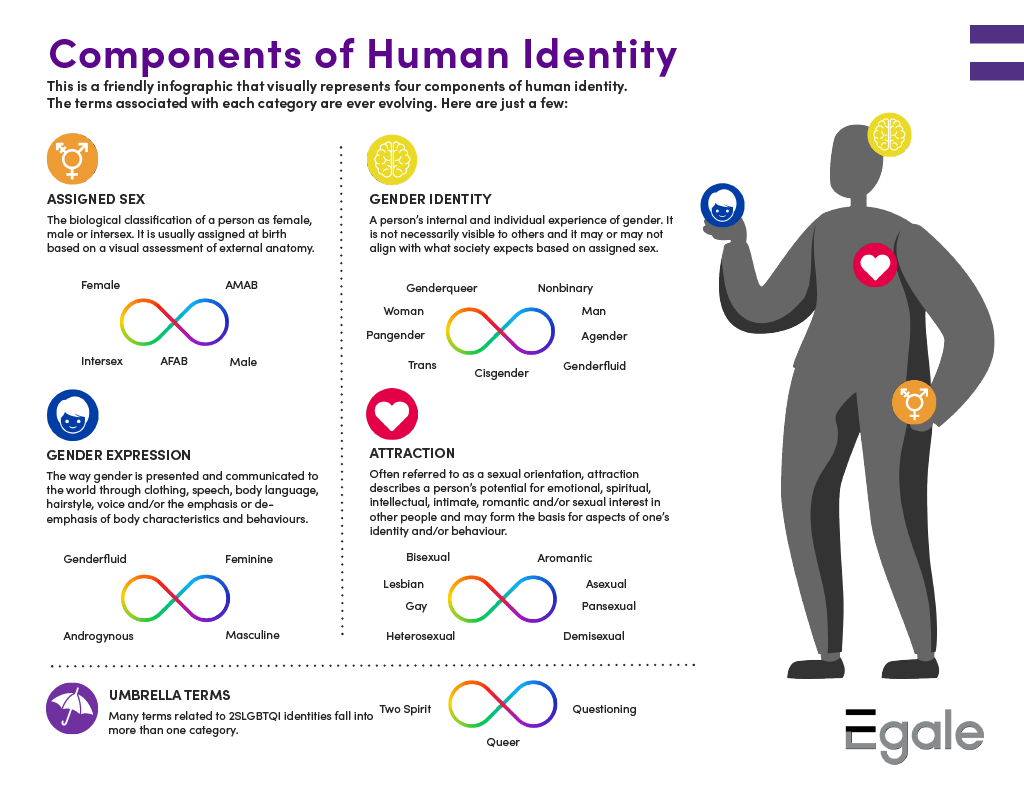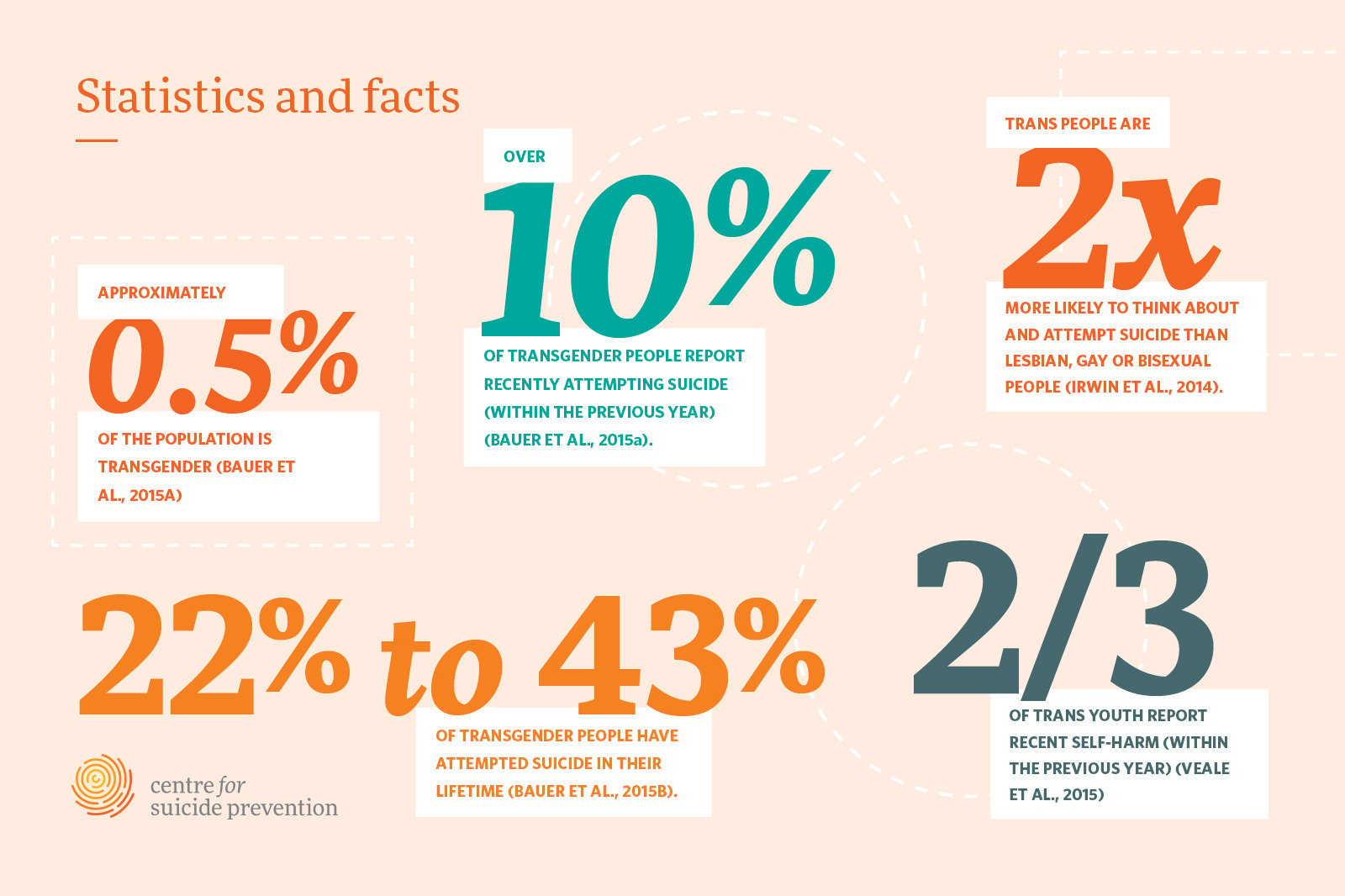Related resources:
- Transgender people and suicide fact sheet
- Sexual minorities and suicide toolkit
- Sexual minorities and suicide fact sheet

Transgender (trans) people face unique stressors, including the stress some trans people experience when their gender identity is not affirmed. Trans people also experience higher rates of discrimination and harassment than their cisgender counterparts and, as a result, experience poorer mental health outcomes. They are also at a greater risk for suicide as they are twice as likely to think about and attempt suicide than LGB people (Haas et al., 2011; McNeill et al., 2017; Irwin et al., 2014).
However, as with sexual orientation, gender identity is not recorded on death certificates, so the exact number of the trans people who die by suicide is hard to determine.
Consequently, there have been little data and research on gender identity, but this is starting to change (McNeill et al., 2017).
Definitions
Transgender (trans) is an umbrella term that represents a wide range of gender identities and expressions. Trans people do not identify either fully or partially with the gender associated with their assigned sex at birth (Canadian Federation of Students, 2017).
Gender identity refers to a personal conception of one’s place on the gender spectrum; the gender that one identifies as may be the same or different from their birth assigned sex.
Alternative terms to transgender include: non-binary, genderqueer and gender fluid (Veale et al., 2015).
Language is very important when discussing gender: it’s helpful to know how someone self-identifies in order to honour their self-expression and create a safe environment in which they can express themselves.
Things to know about language. Trans people may:
- have a fluid gender identity, meaning that their gender expression may fluctuate along with the label with which they identify
- use more than one identity label, for example, “trans woman” and “genderqueer” (McNeill et al., 2017, p.2)
- choose non-binary labels such as “bi-gender,” “androgyne” and “polygender”
- not define a gender at all (this is called “neutrois”) (Bailey et al., 2014).

(Egale Canada Human Rights Trust, 2022).

Are trans people more at-risk of suicide?
Trans people are more at risk of suicide than heterosexual people and lesbian, gay, and bisexual people. Studies and surveys have shown many transgender people have thought about and attempted suicide, and previous suicidal behaviours such as these are the most reliable indicators of future suicide risk (Suicide Prevention Resource Centre [SPRC], 2008).
Transgender people also experience mental illness at significantly higher rates than the general population. This heightened risk is primarily due to the fact that transgender people face unique stressors, including stress from being part of a minority group, as well as stress related to not identifying with one’s biological sex. If left untreated, these mental health disorders can also be indicators for suicide risk.
Risk Factors
Certain factors can place people at a higher risk for suicide than others. These are some risk factors that affect the transgender population particularly:
- Stress related to potential backlash of transitioning
- Stress related to risks and lengthy time period of a medical transition (if one is desired)
- Experience of discrimination (transphobia) in the form of physical or verbal harassment, physical or sexual assault
- Lack of support from parents and other family members
- Institutional prejudice manifesting as laws and policies which create inequalities and/or fail to provide protection from discrimination
- Mental illness (including depression, anxiety)
- Excessive alcohol and/or drug use
- Stigma
- Experience of isolation in a cis-normative society
- Access to lethal means (e.g. firearms, prescription drugs)
- Homelessness
(Bailey et al., 2014; Haas et al., 2011; SPRC, 2008).
Warning signs for those considering suicide
Some warning signs require more immediate action than others. If someone is exhibiting the following warning signs, call 9-1-1:
- Talking about wanting to die or kill oneself; or
- Looking for a way to kill oneself or already having a plan (American Association of Suicidology, 2018).
Homeless trans youth
LGBTQ youth are greatly overrepresented in the homeless youth population in North America (Abramovich, 2012); about 30% of homeless youth identify as LGBTQ compared to 5 to 10% of non-homeless youth. The shelter system (which houses homeless youth intermittently) should be accountable for fostering safe spaces for all youth, irrespective of sexual or gender identity. Staff should be trained on “issues relating to LGBTQ youth culture, terminology, needs, homophobia and transphobia” (Abramovich, 2012, p.47).
Transitioning as both protective and risk factor
The decision to medically transition to the gender with which one identifies can be stressful and may place someone more at risk for suicide. However, studies show that once a transition is completed, it does have beneficial effects.
A survey of trans people in the UK found that a completed medical transition was shown to greatly reduce rates of suicidal ideation and attempts, in contrast to those at other stages of transition (imminently transitioning or beginning transition). 67% of transitioning people thought more about suicide before transitioning whereas only 3% thought about suicide more after their transition (Bailey et al., 2014).
While some trans people undergo medical interventions like hormone therapy or gender reassignment surgery, others may not, choosing to socially transition by changing their name and/or gender presentation.
Choosing one’s own name has positive effects on a trans person’s mental health. The study showed that “having even one context in which a chosen name could be used was associated with a 29% decrease in suicidal thoughts” (Russell, et al, 2018).
Protective Factors
- Membership in Gay-Straight Alliance (GSA) or other school supports
- Supportive and strong relationships with family and friends
- Completed medical transition (if transition is desired)
- Effective mental health care and health care
- Connection to trans community
- Pride in one’s own gender identity
- Self-awareness and acceptance
(Bailey et al., 2014; Bauer et al., 2015; Haas et al., 2011; SPRC, 2008).
Transgender bullying prevention in schools
Schools need to play an active role in ending transgender harassment and discrimination, and in the past few years, many Canadian schools have integrated policies and programs to ensure LGBTQ students feel safe.
- Safe-school policies and procedures specifically addressing transphobia
These policies create an environment where trans as well as lesbian, gay, bisexual and questioning (LGBTQ) students feel safer, more accepted, and more attached to their schools. In schools where these policies are in place, harassment of LGBTQ students is reduced, and in the instances of harassment, LGBTQ students are more likely to report the harassment to school staff and staff is more likely to intervene.
- Policies supported from the division-level to the individual school.
Policies supported from all levels of the school system are most effective as staff and students realize the policies have institutional-wide endorsement and are actively enforced.
- Support for the efforts of students to start Gay-Straight Alliance clubs (GSAs).
GSAs help encourage solidarity amongst a larger group of the student population; LGB students know they are supported by their straight peers (Saewyc et al., 2014; Egale Canada, 2011).
As an example, the Alberta government passed legislation-Bill 24—which strengthens rules around gay-straight alliances in schools. The law makes it more difficult for schools to deny students the right to form GSAs (Bennett, 2017).
Healthcare Practitioners
Trans people often face discrimination in health care settings, yet access to health care is vital for trans people, as those who seek medical transition require specialized care (Veale et al., 2015).
Often young trans people must receive a diagnosis of gender dysphoria to access health care services such as hormone therapy (in preparation for medical transitioning). Gender dysphoria is the extreme levels of distress some people experience due to the discrepancy between one’s assigned sex at birth and the gender with which one identifies.
Healthcare practitioners (including psychologists, nurses, general practitioners, psychiatrists and endocrinologists) need to strengthen adequate and timely access to gender-affirming healthcare for trans communities (Veale et al., 2015). They should be trained in gender diversity, and trans health should become a part of their required curriculum (Strauss et al., 2017).
Other Institutions
The wellbeing of trans people can be greatly affected by the characteristics, norms, practices, and spaces of institutional environments. There is a relationship between denial of access to bathrooms and gender-appropriate campus housing and increased risk for suicidality (Seelman, 2016).
“Suicidality among trans people is incredibly complex; relating to multiple individual, systemic and structural factors. It cannot be located solely within the individual, and any exploration of this must consider intersectional sources of oppression to fully capture its nuances” (McNeil et al., 2017, p.26).
Additional Resource
Trans and Gender Diverse Mental Health, Wellness and Suicide Prevention Toolkit
SPECTRUM, Waterloo Region’s Rainbow Community Space and Wisdom2Action
References
Abramovich, I. (2012). No safe place to go: LGBTQ youth homelessness in Canada: Reviewing the literature. Canadian Journal of Family and Youth, 4(1), 29-51. Retrieved from http://ejournals.library.ualberta.ca/index.php/cjfy/article/download/16579/13220
American Association of Suicidology. (2018). Know the Warning Signs of Suicide. Retrieved from http://www.suicidology.org/resources/warning-signs
Bailey, L., Ellis, S., & McNeil, J. (2014). Suicide risk in the UK trans population and the role of gender transitioning in decreasing suicidal ideation and suicide attempt. Mental Health Review Journal, 19(4), 209-220.
Bauer, G., Zong, X., Scheim, A., Hammond, R. & Thind, A. (2015a). Factors impacting transgender
patients discomfort with their family physicians: A respondent-driven sampling study. PloSONE
2015; 10(12): e0145046. https://doi.org/10.1371/journal.pone.0145046
Bauer, G., Schiem, A., Travers, R. & Hammond, R. (2015b). Intervenable factors associated with suicide risk in transgender persons: A respondent driven suicide risk sampling study in Ontario, Canada. BMC Public Health. DOI: 10.1186/s12889-015-1867-2 .
Bennett, D. (2017, November 15). Alberta passes contentious bill strengthening gay-straight alliance rules. Globe and Mail. Retrieved from https://www.theglobeandmail.com/news/national/alberta-passes-contentious-bill-strengthening-gay-straight-alliance-rules/article36986351/
Egale Canada. (2011). Every Class in Every School: The first national climate survey on homophobia, biphobia, and transphobia in Canadian schools (Final Report – May 2011). Retrieved from http://archive.egale.ca/index.asp?lang=E&menu=4&item=1489
Egale Canada Human Rights Trust (2022, January 7). Genderbread Person: Components of Human Identity. https://egale.ca/awareness/the-genderbread-person/
Haas, A., Eliason, M., Mays, V., Mathy, R., Cochran, S., D’Augelli, A., Silverman, M., Fisher, P., Hughes, T., Rosario, M., Russell, S., Malley, E., Reed, J., Litts, D.A., Haller, E., Sell, R.L., Remafed, G., Bradford, J., Beautrais, A.L., Brown, G.K., Diamond, G.M., Friedman, M.S., Farofalo, R., Turner, M.S., Hollibaugh, A. & Clayton, P. (2011). Suicide and suicide risk in lesbian, gay, bisexual and transgender populations: Review and recommendations. Journal of Homosexuality, 58(1),10-51.DOI: 10.1080/00918369.2011.534038
Irwin, J., Coleman, J., Fisher, C. & Marasco, V. (2014). Correlates of suicide ideation among LGBT Nebraskans. Journal of Homosexuality, 61(8), 1172-1191.
McNeill, J., Ellis, S. & Eccles, S. (2017). Suicide in trans populations: A systematic review of prevalence and correlates. Psychology of Sexual Orientation. DOI:10.1037/sgd0000235. Retrieved from https://scholar.google.ca/scholar?hl=en&as_sdt=0%2C5&q=Suicide+in+trans+populations%3A+A+systematic+review+of+prevalence+and+correlates.+&btnG=
Russell, S., Pollitt, A., Li, G. & Grossman, A. (2018). Chosen name is linked to reduced depressive symptoms, suicidal ideation, and suicidal behavior among transgender youth. Journal of Adolescent Health. DOI: 10.1016/j.jadohealth.2018.02.003
Saewyc, E., Konishi, C., Rose, H., & Homma, Y. (2014). School-based strategies to reduce suicidal ideation, suicide attempts and discrimination among sexual minority and heterosexual adolescents in western Canada. International Journal of Child and Youth Family Studies, 5(1), 89-112.
Seelman, K. (2016). Transgender adults’ access to college bathrooms and housing and the relationship to suicidality. Journal of Homosexuality, 63(10), 1378-1399.
Strauss, P., Cook, A., Winter, S., Watson, V., Wright Toussaint, D. & Lin, A. (2017). Trans Pathways: the mental health experiences and care pathways of trans young people. Summary of results. Telethon Kids Institute, Perth, Australia. Retrieved from https://www.telethonkids.org.au/globalassets/media/documents/brain–behaviour/trans-pathways-summary.pdf
Suicide Prevention Resource Center. (2008). Suicide risk and prevention in gay, lesbian, bisexual and transgender youth. Newton, MA: Education Development Center, Inc. Retrieved from http://www.sprc.org/sites/default/files/migrate/library/SPRC_LGBT_Youth.pdf
Veale, J., Saewyc, E., Frohard-Dourlent, H., Dobson, S., Clark, B. & the Canadian Trans Youth Health Survey Research Group. (2015). Being safe, being me: Results of the Canadian trans youth health survey. Vancouver, BC: Stigma and Resilience Among Vulnerable Youth Centre, School of Nursing, University of British Columbia. Retrieved from https://saravyc.sites.olt.ubc.ca/files/2015/05/SARAVYC_Trans-Youth-Health-Report_EN_Final_Web2.pdf
